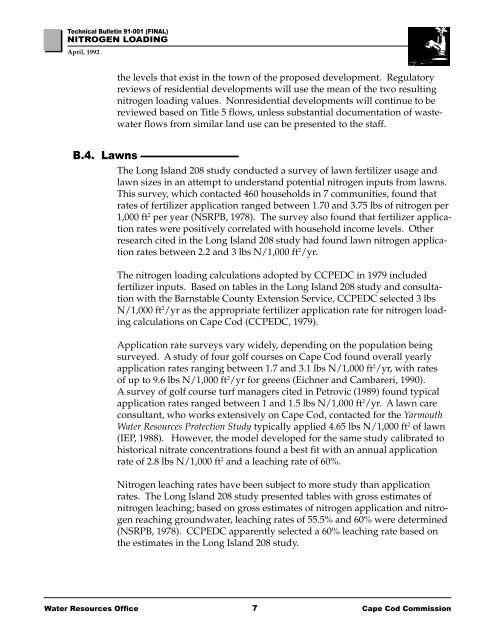Technical Bulletin 91-001 Nitrogen Loading - Cape Cod Commission
Technical Bulletin 91-001 Nitrogen Loading - Cape Cod Commission
Technical Bulletin 91-001 Nitrogen Loading - Cape Cod Commission
You also want an ePaper? Increase the reach of your titles
YUMPU automatically turns print PDFs into web optimized ePapers that Google loves.
<strong>Technical</strong> <strong>Bulletin</strong> <strong>91</strong>-<strong>001</strong> (FINAL)<br />
NITROGEN LOADING<br />
April, 1992<br />
the levels that exist in the town of the proposed development. Regulatory<br />
reviews of residential developments will use the mean of the two resulting<br />
nitrogen loading values. Nonresidential developments will continue to be<br />
reviewed based on Title 5 flows, unless substantial documentation of wastewater<br />
flows from similar land use can be presented to the staff.<br />
B.4. Lawns<br />
The Long Island 208 study conducted a survey of lawn fertilizer usage and<br />
lawn sizes in an attempt to understand potential nitrogen inputs from lawns.<br />
This survey, which contacted 460 households in 7 communities, found that<br />
rates of fertilizer application ranged between 1.70 and 3.75 lbs of nitrogen per<br />
1,000 ft 2 per year (NSRPB, 1978). The survey also found that fertilizer application<br />
rates were positively correlated with household income levels. Other<br />
research cited in the Long Island 208 study had found lawn nitrogen application<br />
rates between 2.2 and 3 lbs N/1,000 ft 2 /yr.<br />
The nitrogen loading calculations adopted by CCPEDC in 1979 included<br />
fertilizer inputs. Based on tables in the Long Island 208 study and consultation<br />
with the Barnstable County Extension Service, CCPEDC selected 3 lbs<br />
N/1,000 ft 2 /yr as the appropriate fertilizer application rate for nitrogen loading<br />
calculations on <strong>Cape</strong> <strong>Cod</strong> (CCPEDC, 1979).<br />
Application rate surveys vary widely, depending on the population being<br />
surveyed. A study of four golf courses on <strong>Cape</strong> <strong>Cod</strong> found overall yearly<br />
application rates ranging between 1.7 and 3.1 lbs N/1,000 ft 2 /yr, with rates<br />
of up to 9.6 lbs N/1,000 ft 2 /yr for greens (Eichner and Cambareri, 1990).<br />
A survey of golf course turf managers cited in Petrovic (1989) found typical<br />
application rates ranged between 1 and 1.5 lbs N/1,000 ft 2 /yr. A lawn care<br />
consultant, who works extensively on <strong>Cape</strong> <strong>Cod</strong>, contacted for the Yarmouth<br />
Water Resources Protection Study typically applied 4.65 lbs N/1,000 ft 2 of lawn<br />
(IEP, 1988). However, the model developed for the same study calibrated to<br />
historical nitrate concentrations found a best fit with an annual application<br />
rate of 2.8 lbs N/1,000 ft 2 and a leaching rate of 60%.<br />
<strong>Nitrogen</strong> leaching rates have been subject to more study than application<br />
rates. The Long Island 208 study presented tables with gross estimates of<br />
nitrogen leaching; based on gross estimates of nitrogen application and nitrogen<br />
reaching groundwater, leaching rates of 55.5% and 60% were determined<br />
(NSRPB, 1978). CCPEDC apparently selected a 60% leaching rate based on<br />
the estimates in the Long Island 208 study.<br />
Water Resources Office 7<br />
<strong>Cape</strong> <strong>Cod</strong> <strong>Commission</strong>
















